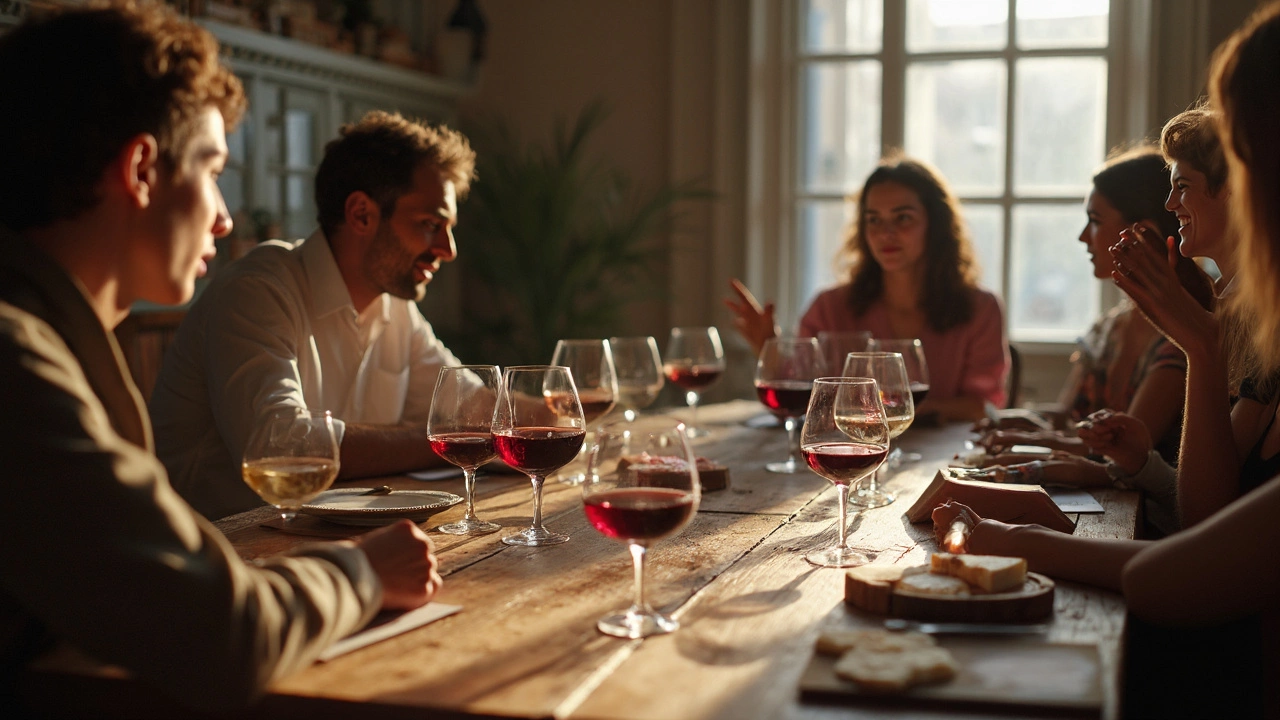People love to talk about wine tasting like it’s some sort of secret club, but honestly, the basics are way simpler than they make it sound. You don’t need fancy jargon, a $300 bottle, or an epic wine cellar—just a little focus on what you’re doing with your senses. The five steps of wine tasting break things down into bite-sized moves that anyone can remember, and walking through them the right way can totally change what you get out of your next glass.
Ever heard someone swirl their wine and look at it like it’s a crystal ball? There’s a reason for that. But the steps aren’t just about looking cool—they dial up all the flavors, aromas, and textures hiding in that pour. Think of it like learning to see, smell, and taste in high-def. And if you’re at a dinner or party, trust me, knowing the five steps instantly makes you the most interesting person standing around the bottle.
Check the Color
First up in wine tasting is checking the color—yeah, before you even think about sipping. Hold your glass by the stem and tilt it over a plain white surface, like a napkin or tablecloth. This isn’t just for show; color tells you things about the wine’s age, grape, and even if there are any problems with it.
Reds can run from almost purple to brick red, whites can range from pale yellow to deep gold, and rosés land somewhere between. As wine gets older, reds usually turn more brown or orange at the edges, while whites pick up darker gold shades. Younger wines look brighter and more vibrant. Here’s a quick guide to what color might clue you in on:
- Pale whites: Likely younger, crisper, and lighter (think Pinot Grigio).
- Deep gold whites: Often aged, richer, maybe oaked (like aged Chardonnay).
- Purple reds: Very young wines, often from grapes like Malbec or Syrah.
- Ruby reds: Classic for most red wines like Merlot.
- Brick or brown reds: Usually older wines, possibly very mature Bordeaux.
If the color looks murky or you spot weird sediments floating around, that could be a sign something’s off—maybe the wine is spoiled or has a fault. But don’t freak out at every speck; some sediment in old reds is totally normal.
| Wine Type | Youthful Color | Aged Color |
|---|---|---|
| Red | Purple, Ruby | Brick, Brownish-Red |
| White | Pale Yellow, Straw | Deep Gold, Amber |
| Rosé | Pale Pink | Salmon, Copper |
So next time you pour a glass, don’t rush. Take a second to really look—the color is the wine’s first way of telling its story before you smell or taste a thing.
Give it a Swirl
This step might look flashy, but there’s real science behind it. Swirling wine isn't just for show—it's about firing up the aromas. When you swirl, you’re exposing the wine to oxygen. That quick bit of air time can help stubborn flavors open up and show what they’ve got. Reds benefit most from this because they’re packed with complex compounds, but even whites can reveal a little more with a gentle spin.
If you’re new to swirling, keep it simple. Set your glass on the table, pinch the stem, and make small circles. You’ll avoid spills and still get full effect. Don’t bother swirling sparkling wine—bubbles and fizz don’t mix well with spinning.
- Swirling helps wine tasting because it lets volatile compounds lift up from the glass. Those compounds carry all the good stuff your nose wants to smell.
- Wine experts say most people can smell five to ten times more flavors than they can taste. That’s why swirling is key—it’s all about the nose.
- For best results, use a glass with a wider bowl. It gives the wine more space to move and lets the scents concentrate at the top.
| Wine Style | Swirling Impact |
|---|---|
| Red Wine | Opens up complex aromas and flavors |
| White Wine | Releases hidden fruit or floral notes |
| Sparkling Wine | Minimal swirling; keeps bubbles intact |
Here’s a quick stat from a sensory study in California: professionals can pick out nearly 50% more unique scents from a wine after swirling compared to letting it sit flat. The takeaway? If you skip this step, you’re missing out on what your wine can really do.

Inhale Deeply
This is where most of the magic happens in wine tasting. Smell makes up around 80% of what we call flavor. So if you skip sniffing, you miss almost everything that makes each wine unique. Swirl the wine first, which helps release thousands of tiny aroma compounds, then stick your nose in the glass and take a few slow, deep sniffs.
Don’t be shy about it—nobody cares if you look silly. The aim is to pull those scents right into your nose and brain. You’ll notice fruit, spices, wood, herbs, and sometimes wilder stuff like earth, smoke, or even petrol, especially if you’re smelling certain Rieslings. Each wine variety and region gives off its own set of typical smells. For example, Cabernet Sauvignon often has notes of blackcurrant, green pepper, or cedar. Sauvignon Blanc? Grapefruit, gooseberry, or grass.
- If it smells like nothing, swirl again or let it sit. Some wines need air to “open up.”
- If it smells like vinegar, nail polish, or wet cardboard, it might be bad—don’t drink it.
- Resist the urge to label everything. Just focus on what you honestly notice. There are no wrong answers.
If you're ever at a loss, here's a quick trick: compare what you smell to familiar things, like berries, coffee, or toast. And if you're tasting multiple wines, sniff plain coffee beans in between to refresh your nose.
| Aroma | Wine Type | Usual Meaning |
|---|---|---|
| Cherry, raspberry, plum | Red wines (Pinot Noir, Merlot) | Grapes grown in moderate climates |
| Lemon, green apple | White wines (Chardonnay, Sauvignon Blanc) | Younger wines, cooler regions |
| Vanilla, spice | Oaked wines | Oak barrel aging |
| Earth, mushroom | Old World reds | Soil influence or bottle age |
Bottom line: your nose is your best tool here. Take your time, sniff more than once, and let your brain process those layers.
Take a Sip
This is where you actually get to enjoy the wine. It's more than just drinking—when you taste wine the right way, you catch layers of flavor, texture, and even mood that you just can't get from a regular gulp. Slow down here. Your goal isn’t to chug but to let the wine show you what it’s got.
Start by taking a small sip and let it roll around your mouth. This means letting the wine hit all parts—your tongue, cheeks, even under your tongue—since each spot picks up something different. You might taste fruit at the tip of your tongue, feel acidity on the sides, and catch bitterness in the back. This is a big reason why tasting isn’t the same as just drinking.
- Notice the temperature—the best reds are usually around 60-65°F, whites a bit cooler. Too cold? Flavor shuts down. Too warm? Can taste sloppy and flat.
- Is it sweet, dry, tangy, spicy, or maybe bold and oaky? Try to name what stands out. Most people miss half the notes in a wine tasting because they rush.
- Pay attention to texture—some wines feel silky, others gritty or even creamy. This part is called the “mouthfeel.”
Want some reference points? Check out these common flavors people notice depending on the type of wine:
| Type | Common Tastes | Texture (Mouthfeel) |
|---|---|---|
| Cabernet Sauvignon | Blackberry, green pepper, tobacco | Bold, grippy |
| Pinot Noir | Cherry, raspberry, earthy | Light, smooth |
| Chardonnay | Apple, vanilla, butter | Rich, creamy |
| Sauvignon Blanc | Citrus, grass, green apple | Crisp, zippy |
Here’s a quick tip—if you want to taste like a pro, try gently sucking in a little air through your mouth while the wine is still in there. It sounds weird, but it spreads the wine around, wakes up those flavors, and gives you a better idea of what’s going on. Just don’t overdo it or you’ll look like you’re gargling at the table.
Jot down what stands out to you. Don’t worry about sounding fancy. Even pros take notes like “reminds me of strawberry jam” or “feels sharp.” The more you taste and compare, the easier this step gets.

Think About the Finish
This is the step where your wine tasting comes full circle—what sticks around after that first sip tells you a lot. The “finish” is basically how long the flavors and sensations hang out in your mouth once you swallow or spit. Some wines call it quits right away, others keep going and change as the seconds tick by. In pro circles, a finish lasting more than 30 seconds earns some serious respect.
Why care? A wine’s finish is usually a big clue to quality. Wines with a longer finish tend to come from better grapes and careful winemaking. It’s not just about time, though—it’s the richness, balance, and how enjoyable those lingering tastes are. Sometimes you’ll notice a shift: maybe the fruit fades but some hint of vanilla or pepper kicks in late. That’s why the finish gets people talking.
“The mark of a great wine is its ability to leave a lasting impression. A memorable finish distinguishes everyday wine from the truly special.” — Jancis Robinson, Master of Wine
Try this: After you swallow, count slowly in your head. What flavors stick around? Are they pleasant or do they turn sharp and harsh? You can even jot quick notes like “berry lingers, a bit of oak, dries out at the end” so you remember what you liked (or didn’t) for next time.
- Light, easy wines (like Pinot Grigio) might have a short 5-10 second finish.
- Big reds (like Cabernet Sauvignon) often stick with you for 20-40 seconds.
- Sweet wines sometimes leave honeyed flavors that last a full minute or more.
Fun fact: In a recent tasting event by Wine Spectator, wines with longer, smoother finishes consistently scored 90 points or higher. Check the data below for what the judges looked for during their reviews:
| Wine Type | Average Finish Length (seconds) | Typical Flavors Detected |
|---|---|---|
| Pinot Noir | 17 | Berry, earth, subtle spice |
| Cabernet Sauvignon | 35 | Cassis, cedar, dark chocolate |
| Moscato | 12 | Peach, orange blossom |
| Port | 55 | Dark fruit, caramel, nutty |
Bottom line: The finish isn’t just for snobs—it’s the snapshot that sticks in your memory after every glass. Next time, pay attention to what the wine leaves behind. That’s where a lot of the fun (and flavor) really lives.


